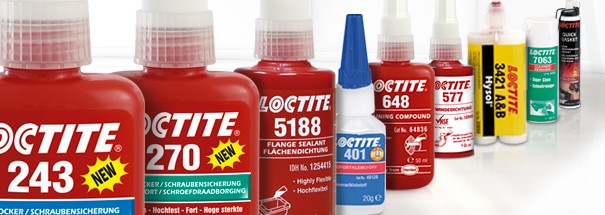
About Loctite

About Loctite
The Basics
As mentioned in the Fastener Page, many aspects of my recommendations come from mission critical and/or life safety application. Loctite is a great product in many of those type of fields but it is critical to accurately apply the correctly chosen product. Choosing the wrong one or inproperly applying the product can be worse than not using it at all.
To start: Loctite is a brand name. Now owned by the Henkel Corporation. They make a LOT of products. Many people refer to “use some Loctite” to mean a threadlocker because that is what the company became famous for (or well known at least). This has really become an inaccurate and useless reference. There are so many different “Loctite” products that you must specify which one. There are numerous threadlockers (220, 242, 243, 263, 246, 294, 2422, 2620, and so on) as well as thread sealants, retainers, primers, adhesives, etc.
A little education goes a long way to being able to take advantage of these great products by allowing you to select the proper one for the job as well as knowing the right method to apply them (ex: primering).
Blue or Red? It is insufficient these days to say "blue" or "red" because there are many products in these categories. And there is also green or purple as well! They can have different operating temperatures, break/prevail torques, with or without primer, wicking or not, and meant for different size fasteners (see my cheat sheet as an example).
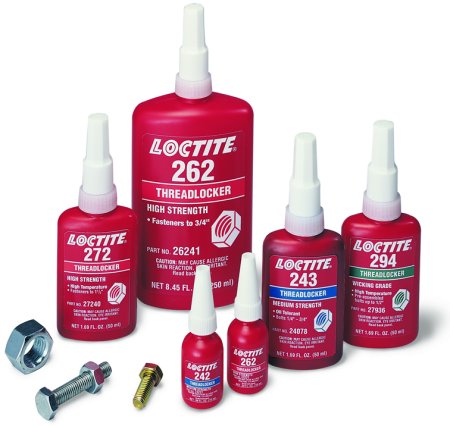
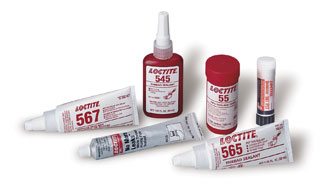
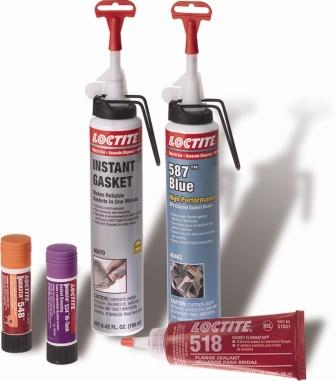
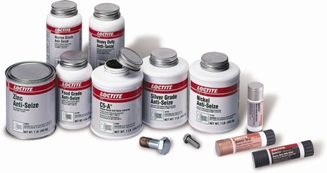
This is just a fraction of products manufactured by the Loctite Company
It is preferable and accurate and state Loctite THREADLOCKER or SEALANT or RETAINER and/or the number when referencing it's use. This is ESPECIALLY important if the other person does not understand the differences in the products. You certainly do not want someone putting on 263 if they take the fastener off regularly (263 is meant to be permanent can be difficult without applying heat to loosen the fastener).
I am a believer in Loctite and use it in many instances. The trick is to understand how the product(s) work so you can apply it to your task properly. In simple terms the threadlocker fills in the microscopic gaps between threads that exists between fasteners. These gaps allow for oxidation, movement, contamination, etc. The threadlocker fills in these gaps and turns into a type of thermoplastic that prevents movement (thereby holding the fastener from loosening) as well as prevent corrosion or oxidation too. Many of the products are anaerobic which can be beneficial (see below). There are also threadlockers that are ‘wicking type’ (220, 290, 294) so they can be applied after the fasteners are together (or torqued). See the reference page here for some links to the Loctite Company Application Guides. They will provide accurate, detailed, and up-to-date information better than anywhere else.
A quick reference to the ones that are anaerobic - what this means is that it will not set or cure until you remove it from an oxygen environment (remove it from the air) and subject it to metal ions. This is why some bolts can come pre-treated with a threadlocker or gasket sealant and still be usable. It won't cure until you thread it in and tighten it (thereby removing it from the air). It is also an important factor when deciding on using a primer.
I'm not going to address each individual product because that would take a lot of time and there is already this information, in great detail, available from the company online. Heck even I use a sheet that hangs by my loctite product bins as a reference because I can't remember each and every product number specs (click here to see my threadlocker ref sheet-will open in a popup window). I can say that the product I use most would be the 243.
Change the Torque Value?
There are two different thoughts in the fastener industry about whether a threadlocker will change the dry torque spec of the bolt yield point. My opinion is the truth is somewhere in the middle. Those that say up to 20% increase of friction reduction I disagree with. But those that say zero change (ex: permatex company) I disagree with too. I have found that I agree with this: When viewing the recommended torque RANGE of a fastener (example – FSM ranges) and you apply a threadlocking compound that isn’t called for in the manual (ie-not already accounted for) then use the lower of the torque range value. Of course if the FSM specifies using a locking compound then go with the same values as you ordinarily would.
In other words – yes I agree it can change the torque value needed to achieve the right preload as opposed to a clean and dry bolt/fastener. But I still find it is within the range accepted for the fastener itself. If the range for a clean dry bolt is,say, 18-24 ftlbs and you want to apply a threadlocker to keep it in place better or help prevent corrosion, then torque to 18 ftlbs.
If you are not sure of this logic then you can always go clean dry, torque, then apply a wick type as mentioned above. If the location of the fastener allows for you to get the product onto it once it is torqued. Wicking types would be threadlocker # 220, 290, or 294.
Again, I’m not going to get too detailed about the different products or application. There’s a lot of them (products as well as good applications on the 3000, especially those modified for racing). There is a lot of technical info available online from the Loctite corporation or henkel’s website. They also have a really nice catalog with technical data (free upon request!) or downloadable technical data sheets.
From a car mechanic/technician point of view, these products (aka “Loctite”) become more useful and valuable the more you understand their proper applications.
Take the time to examine the specification differences in the basic line of products as well as the range of them available. There are basic categories to begin:
THREAD LOCKERS - used to hold fasteners in place, reduce corrosion, resist loosening. The original line of products that most people think of when you say loctite.
RETAINERS - used for things such as holding bearings in place, filling in gaps on worn bushings, etc. A nice product line that is often overlooked but can be invaluable in automotive applications.
THREAD SEALANTS - used to seal up threads to prevent leaking and/or corrosion. Good for hydraulic or pressurized systems to help give a total seal and prevention of leaking, dripping or weeping. Often mistaken as a locking type product but it is entirely different.
GASKETING - used to hold gaskets in place, seal gaps, use with or without gaskets, and much more. A wide range of products available.
ANTISEIZE - Loctite makes a large lineup of antiseize products including in the "stix" type.
ADHESIVE - Loctite has an entire range of adhesives for most every application imaginable.
With all that being said here's a few other things:
Unsure of what product to have on hand or use? Well you're not alone because there are so MANY to select from. The best thing to do is know your application then view the information on the product selector sheets and be guided by that. Loctite makes some nice guide sheets to help you decide (links to them are in the reference area here).
I keep a lot of them on hand for all different applications.
Here's the main ones I use as well as a photo of the loctite cabinet in my shop.
Click Image to open a larger version in a new window.
For a shop I'd say a minimum would be 242 or 243 (for medium strength) and some 262 or 263 (for high strength). If you are going to be in high temperature applications then perhaps think about some 2422 and/or 2620 as this is for up to 650F. Note that is is more expensive than the standard 242 or 262. Also, you might want some wicking type and can choose the 220 for medium strength or 290/294 for high strength. If you want to secure small set screws but not overdo it use some 222 purple low strength.
 |
They also make what they call "STIX" which are very handy. They are less waste or mess and easy to have on hand in your tool box. They don't spill either so that can be an added benefit. They come in medium strength locker (aka - blue #248) and also high strength locker (aka - red #268). You can also get thread sealant #561 in stix form and gasketing sealants #548 and #534 in stick form. They also offer the 7088 PRIMER in stix form as well as two anti-seize formulas and a retaining formula too (#668). The kit (photo on the right) is a nice starter pack and is about $50 retail. |
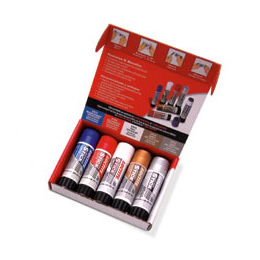 |
PRIMER
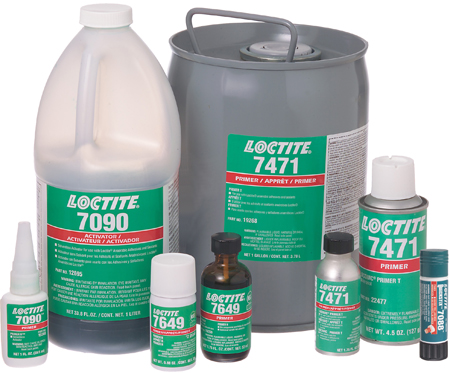
Don't confuse primer with cleaner as they are different.
Don't confuse primer with activator as they are different.
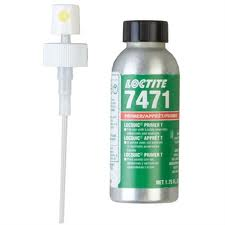 |
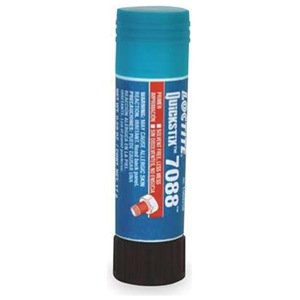 |
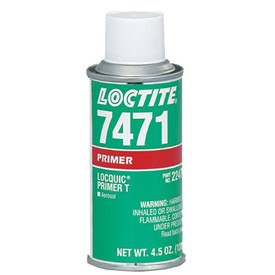 |
There are also a couple of different primers. They come in spray, pump, stick and liquid dropper. Most of the threadlockers and other products work well on CLEAN threads so a cleaner will help if the fastener or threads is dirty or oily. So make sure you are familiar with the difference of primer, activator or cleaner. Some products work better with bolts that are a bit oily in nature (see specs). Loctite makes a good cleaner but you can also use a brake cleaning spray too (ie - brakleen). It also might be a little easy to locate/buy, especially locally.
The actual primer itself can be used for a couple different purposes. It is much more than a cleaner. Many of the locking products benefit from using a primer first but mainly the anaerobic ones. It can also be used for anaerobic sealants (like 518 gasket maker) too.
1) If you want to speed up the cure time of a product then a primer can help you do that.
2) If you are joining a inactive metal -which are low in metal ions - to active metal (or vice-versa) then the primer is useful to prevent certain undesirable reactions (like Stainless Steel Galling).
Like many sections here, go to the reference page for more details and instructions on proper selection and use.
WHERE TO BUY?
There are more dealers than products! But which dealer has a full range of all the products you want or need and a good price? Well, shop around as there are many places and if you only need 1 or 2 basic items it will be easy to find. If your want more products or maybe some not stocked by some smaller dealers I suggest Betty Mills Company (they have so much stuff it's unbelievable) or one of my other favorite places is drillspot.
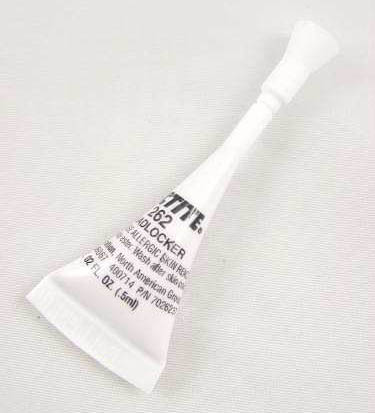 3ml size is great for specialty products |
You might find that some of the specialty products are more costly that you thought. It can be expensive, especially if buying in larger containers. If you are only the occasional user then I'd suggest getting the smaller 3ml containers. 10ml is a nice size for something you know you use fairly often such as maybe 242 or 243. Myself I have mostly 10ml for the main product lines and then some 3ml or 6ml for special use ones. For 243 I keep a 50ml bottle handy because it gets used the most. Or go with just the stick if you just need a basic medium or high strength locker. |
Now that you know a little more I'm sure you are ready to look in your tool box and see what you have on hand versus what you might like to have after learning about the product line. Take a moment to look at the reference pages here where you will find very useful guides that loctite has as well as application instructions and more. If you take a little time to learn about their product lineup and the specs, indications, precautions, etc. then you are much better prepared to get the full benefit from using the correct product properly.
See Reference Pages for more detail data
I hope you found this information useful. I pretty much just typed this all out at one sitting so if there's any typos or mistakes I missed let me know!